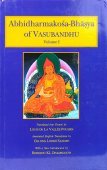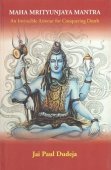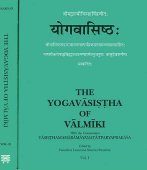Karika, Kārikā, Karikā: 23 definitions
Introduction:
Karika means something in Buddhism, Pali, Hinduism, Sanskrit, Jainism, Prakrit, the history of ancient India, Marathi, Hindi, biology. If you want to know the exact meaning, history, etymology or English translation of this term then check out the descriptions on this page. Add your comment or reference to a book if you want to contribute to this summary article.
In Hinduism
Natyashastra (theatrics and dramaturgy)
Source: archive.org: Natya ShastraKārikā (कारिका, “memorial verse”).—When a rule (lit. meaning) is explained (lit. uttered) briefly in a with a minimum (lit. small) number of words, it is called the Memorial Verse (kārikā) which shows the meaning of the rule clearly.

Natyashastra (नाट्यशास्त्र, nāṭyaśāstra) refers to both the ancient Indian tradition (shastra) of performing arts, (natya—theatrics, drama, dance, music), as well as the name of a Sanskrit work dealing with these subjects. It also teaches the rules for composing Dramatic plays (nataka), construction and performance of Theater, and Poetic works (kavya).
Vyakarana (Sanskrit grammar)
Source: Wikisource: A dictionary of Sanskrit grammarKārikā (कारिका).—A verse or a line or lines in metrical form giving the gist of the explanation of a topic; cf. संक्षिप्तसूत्रबह्वर्थसूचकः श्लोकः कारिका (saṃkṣiptasūtrabahvarthasūcakaḥ ślokaḥ kārikā) Padavyavasthāsūtrakārikā of Udayakīrti.

Vyakarana (व्याकरण, vyākaraṇa) refers to Sanskrit grammar and represents one of the six additional sciences (vedanga) to be studied along with the Vedas. Vyakarana concerns itself with the rules of Sanskrit grammar and linguistic analysis in order to establish the correct context of words and sentences.
Shaktism (Shakta philosophy)
Source: Google Books: ManthanabhairavatantramKārikā (कारिका) refers to “she who instills (certainty)”, according to the Kulakaulinīmata verse 4.71-75.—Accordingly, “(Kuṇḍalinī) bestows (marital) bliss and so is said to be Nityā (the Eternal Woman). She brings about growth (and development) and is the eternal (nityā) mother of the universe who instills certainty (niścaya-kārikā). She is the eternal Transmental. Devoid of the universe of thought constructs, she resides in the life breath of all. She is the supreme energy, called Kuṇḍalā and is the seventeenth energy (of the Moon). [...]”.

Shakta (शाक्त, śākta) or Shaktism (śāktism) represents a tradition of Hinduism where the Goddess (Devi) is revered and worshipped. Shakta literature includes a range of scriptures, including various Agamas and Tantras, although its roots may be traced back to the Vedas.
In Buddhism
Theravada (major branch of Buddhism)
Source: Pali Kanon: Pali Proper NamesA grammatical work in Pall, written by the Elder Dhammasenapati at the Ananda vihara in Pagan. A tika on the work is ascribed to the same author. Gv. p.63, 73; Bode, op. cit., 16 and n.1.
Theravāda is a major branch of Buddhism having the the Pali canon (tipitaka) as their canonical literature, which includes the vinaya-pitaka (monastic rules), the sutta-pitaka (Buddhist sermons) and the abhidhamma-pitaka (philosophy and psychology).
General definition (in Buddhism)
Source: Abhayagiri: General Essay'sThe Karika is a verse commentary on the Upanishad. It falls into four sections:
- Agama Prakarana
- Illusion
- Advaita
- Extinguishing the torch.
1. The first section is a brief systematic exposition of the Upanishadic text, following its distinction of the four states of consciousness. Several of the most important Indian commentators treat the 29 slokas (verses) of the Agama Prakarana as part of the scriptural text of Mandukya Upanishad..
2. The second section moves beyond the text of the Upanishad to establish the unreality of the things experienced in dreams and, by analogy, the things experienced in the waking state.
3. The Advaita section of the Karika presents a clear, positive statement of the Non-Dualist position: Atman/Brahman alone is real, all else is illusion. Gaudapada teaches the AJATA doctrine: the doctrine of NO-BECOMING.
4. The fourth section of the Karika expounds the means of removing the illusion of duality. Essentially this is the ASPARSHA YOGA mentioned in section three.
In Jainism
Jain philosophy
Source: archive.org: Anekanta Jaya Pataka of Haribhadra SuriKārikā (कारिका) usually refers to “memorial verse” or a “collection of such verses (on a philosophical or scientific subject)” (e.g., Bhartṛhari’s Kārikās on grammar), as occurring in the Anekāntajayapatākā-prakaraṇa, a Śvetāmbara Jain philosophical work written by Haribhadra Sūri.—[Cf. Vol. I, P. 50, l. 28]—Here Kārikā stands for a collection of verses This word occurs on p 375, l. 11. It is used m connection with the introductory verses of the Bhāṣya of Tattvārthasūtra by Devagupta Sūri and Gandhahastin Siddhasena Gaṇī (vide p 19 and p 20 respectively of Vol I).
-
India history and geography
Source: Cologne Digital Sanskrit Dictionaries: Indian Epigraphical GlossaryKarika.—(Ep. Ind., Vol XIII, p. 119, text line 8), official designation; probably a mistake for Tarika. Note: karika is defined in the “Indian epigraphical glossary” as it can be found on ancient inscriptions commonly written in Sanskrit, Prakrit or Dravidian languages.

The history of India traces the identification of countries, villages, towns and other regions of India, as well as mythology, zoology, royal dynasties, rulers, tribes, local festivities and traditions and regional languages. Ancient India enjoyed religious freedom and encourages the path of Dharma, a concept common to Buddhism, Hinduism, and Jainism.
Biology (plants and animals)
Source: Google Books: CRC World Dictionary (Regional names)1) Karika in India is the name of a plant defined with Aristolochia bracteata in various botanical sources. This page contains potential references in Ayurveda, modern medicine, and other folk traditions or local practices.
2) Karika is also identified with Phoenix dactylifera It has the synonym Palma major Garsault (etc.).
Example references for further research on medicinal uses or toxicity (see latin names for full list):
· Observationes Botanicae (Retzius) (1791)
· The Gardeners Dictionary (1768)
· Matiere médicale (1767)
· Taxon (1979)
· Description, vertus et usages
· animaux
If you are looking for specific details regarding Karika, for example chemical composition, extract dosage, health benefits, pregnancy safety, side effects, diet and recipes, have a look at these references.

This sections includes definitions from the five kingdoms of living things: Animals, Plants, Fungi, Protists and Monera. It will include both the official binomial nomenclature (scientific names usually in Latin) as well as regional spellings and variants.
Languages of India and abroad
Pali-English dictionary
Source: BuddhaSasana: Concise Pali-English Dictionarykārikā : (f.) a commentary.
Source: Sutta: The Pali Text Society's Pali-English DictionaryKārikā, see kāraka. (Page 210)

Pali is the language of the Tipiṭaka, which is the sacred canon of Theravāda Buddhism and contains much of the Buddha’s speech. Closeley related to Sanskrit, both languages are used interchangeably between religions.
Marathi-English dictionary
Source: DDSA: The Molesworth Marathi and English Dictionarykārikā (कारिका).—f S An expository stanza.
--- OR ---
kārīka (कारीक).—a R (kāra) Prepared or wrought with manure.
Source: DDSA: The Aryabhusan school dictionary, Marathi-Englishkārikā (कारिका).—f An expository stanza.
Marathi is an Indo-European language having over 70 million native speakers people in (predominantly) Maharashtra India. Marathi, like many other Indo-Aryan languages, evolved from early forms of Prakrit, which itself is a subset of Sanskrit, one of the most ancient languages of the world.
Sanskrit dictionary
Source: DDSA: The practical Sanskrit-English dictionaryKarikā (करिका).—Scratching, a wound caused by a fingernail. 'दिग्दष्टे वर्तुलाकारे करिका नखरेखिका (digdaṣṭe vartulākāre karikā nakharekhikā)' इति वैजयन्ती (iti vaijayantī); Śiśupālavadha 4.29.
--- OR ---
Kārikā (कारिका).—
1) A female dancer.
2) A business, or trade
3) A memorial verse, or a collection of such verses, on grammatical, philosophical, or scientific subjects, e. g. Bhattojī Dīkṣita's Kārikās on grammar; called वैयाकरणसिद्धान्तकारिका (vaiyākaraṇasiddhāntakārikā); सांख्यकारिका (sāṃkhyakārikā).
4) Torment, torture.
5) Interest.
Source: Cologne Digital Sanskrit Dictionaries: Edgerton Buddhist Hybrid Sanskrit DictionaryKārika (कारिक).—(-kārika), adj. (= Sanskrit kālika; compare 2 kāra), ifc., belonging to a…time: Lalitavistara 40.11 (prose) nānāpuṣpaphalavṛkṣā nānar- tukārikās (only one inferior ms. °kālikās),…trees belonging to the time of various seasons, or to various seasons and times.
Source: Cologne Digital Sanskrit Dictionaries: Shabda-Sagara Sanskrit-English DictionaryKārikā (कारिका).—f.
(-kā) 1. An actress, a dancing woman. 2. Action, agency. 3. Comment, gloss. 4. An art, a profession. 5. Sharp pain, 6. Interest at any stipulated rate. E. kṛñ to do, and vun affix, fem. termination ṭāp and i substituted for the penultimate vowel.
Source: Cologne Digital Sanskrit Dictionaries: Aufrecht Catalogus Catalogorum1) Kārikā (कारिका) as mentioned in Aufrecht’s Catalogus Catalogorum:—[grammatical] W. p. 222.
—by Bhaṭṭoji. B. 3, 4.
—by Bhartṛhari. Oppert. 4267. Quoted by Viṭṭhala Oxf. 161^b. See Vākyapadīya.
2) Kārikā (कारिका):—vaid. Āśvalāyana. B. 1, 152. 154. Sb. 16.
—Gobhila. B. 1, 174.
—Śākala. K. 196.
—Śaunaka. K. 198. B. 1, 192. 194.
—by Reṇukācārya. B. 1, 164. See Āśvalāyanagṛhyakārikā, Kapardikārikā, Śākalācāryakārikā, Śaunakakārikā.
3) Kārikā (कारिका):—[dharma] by Anantadeva. B. 3, 66.
4) Kārikā (कारिका):—[nyāya] Rice. 98.
5) Kārikā (कारिका):—kārikāḥ vedānta, by Harirāya. Peters. 3, 392.
—[commentary] by Gokulabhaṭṭa. Peters. 3, 392.
1) Karikā (करिका):—[from karaka > kara] a f. (ikā) a wound caused by a finger-nail, [Śiśupāla-vadha iv, 29.]
2) Karika (करिक):—[from kara] m. ifc. (= karin) an elephant, [Śiśupāla-vadha iv, 29]
3) Karikā (करिका):—[from karika > kara] b f. See 1. karaka
4) Kārikā (कारिका):—[from kāra] f. (f. of kāraka), a female dancer, [cf. Lexicographers, esp. such as amarasiṃha, halāyudha, hemacandra, etc.]
5) [v.s. ...] a business, [cf. Lexicographers, esp. such as amarasiṃha, halāyudha, hemacandra, etc.]
6) [v.s. ...] trade, [cf. Lexicographers, esp. such as amarasiṃha, halāyudha, hemacandra, etc.]
7) [v.s. ...] concise statement in verse of ([especially] philos. and gramm.) doctrines, [Mahābhārata ii, 453 etc.]
8) [v.s. ...] torment, torture, [cf. Lexicographers, esp. such as amarasiṃha, halāyudha, hemacandra, etc.]
9) [v.s. ...] interest, [cf. Lexicographers, esp. such as amarasiṃha, halāyudha, hemacandra, etc.]
10) [v.s. ...] Name of a plant, [cf. Lexicographers, esp. such as amarasiṃha, halāyudha, hemacandra, etc.]
11) [v.s. ...] f. [plural] or more commonly hari-kārikās, the Kārikās of Bhartṛ-hari id est. the verses contained in his gramm. work Vākya-padīya (q.v.)
Source: Cologne Digital Sanskrit Dictionaries: Yates Sanskrit-English Dictionary1) Karika (करिक):—[(kaḥ-kā)] 1. m. f. Foot mark.
2) Kārikā (कारिका):—(kā) 1. f. An actress; an action; an art; interest.
Source: DDSA: Paia-sadda-mahannavo; a comprehensive Prakrit Hindi dictionary (S)Kārikā (कारिका) in the Sanskrit language is related to the Prakrit words: Āriā, Karia, Kāriyā.
[Sanskrit to German]
Sanskrit, also spelled संस्कृतम् (saṃskṛtam), is an ancient language of India commonly seen as the grandmother of the Indo-European language family (even English!). Closely allied with Prakrit and Pali, Sanskrit is more exhaustive in both grammar and terms and has the most extensive collection of literature in the world, greatly surpassing its sister-languages Greek and Latin.
Hindi dictionary
Source: DDSA: A practical Hindi-English dictionaryKārikā (कारिका):—(nf) versified interpretation, commentary in verse.
...
Kannada-English dictionary
Source: Alar: Kannada-English corpusKarika (ಕರಿಕ):—[noun] a man of black complexion.
--- OR ---
Kārika (ಕಾರಿಕ):—[noun] a kind of plant.
--- OR ---
Kārika (ಕಾರಿಕ):—[noun] = ಕಾರೀಕ [karika].
--- OR ---
Kārīka (ಕಾರೀಕ):—
1) [noun] the palm tree Phoenix dactylifera of Arecaceae family, that has a stout trunk and large leaves; date palm.
2) [noun] its sweet, fleshy fruit having a large, hard seed.
Kannada is a Dravidian language (as opposed to the Indo-European language family) mainly spoken in the southwestern region of India.
See also (Relevant definitions)
Starts with (+27): Karakarigamdu, Karikabhashya, Karikacceti, Karikaci, Karikacuhullu, Karikadale, Karikadarpana, Karikaddihullu, Karikai, Karikakara, Karikakke, Karikal-valavan, Karikala, Karikali, Karikam, Karikamanjari, Karikamaram, Karikana, Karikanavalli, Karikanibandha.
Ends with (+241): Abhedakarika, Abhisamskarika, Acaryakarika, Adhanakarika, Adharakarika, Adhikarika, Aggakarika, Agnicayanakarika, Agnicitikarika, Agnicitkarika, Agnikarika, Agnimukhakarika, Agnishtomakarika, Ahamkarika, Ahnikakarika, Akarika, Akarshakarika, Alamkarakarika, Alamkarika, Alankarika.
Full-text (+407): Navakarika, Agnikarika, Dikkarika, Bhattakarika, Janghakarika, Karikam, Brahmakarika, Adharakarika, Anjalikarika, Karia, Cirakarika, Samkhyakarika, Mulakarika, Utsrishtikarika, Ekadashaskandharthanirupanakarika, Harikarika, Anitkarika, Karaka, Kapardikarika, Lajakarika.
Relevant text
Search found 103 books and stories containing Karika, Kārikā, Kārīka, Karikā, Kārika; (plurals include: Karikas, Kārikās, Kārīkas, Karikās, Kārikas). You can also click to the full overview containing English textual excerpts. Below are direct links for the most relevant articles:
Sahitya-kaumudi by Baladeva Vidyabhushana (by Gaurapada Dāsa)
Text 1.2 < [Chapter 1 - The Purpose of Poetry]
Definitional Verses (kārikā), Elaborations (vṛtti), and Numeration < [Introduction]
Text 10.53 < [Chapter 10 - Ornaments of Meaning]
Consciousness in Gaudapada’s Mandukya-karika (by V. Sujata Raju)
The three levels of knowledge < [Chapter 6: A Study of Māṇḍūkya Kārikā: Alātaśānti Prakaraṇa]
Further analysis of waking and dream experiences < [Chapter 6: A Study of Māṇḍūkya Kārikā: Alātaśānti Prakaraṇa]
Mandukya Upanishad (Gaudapa Karika and Shankara Bhashya) (by Swami Nikhilananda)
Mandukya Karika, introduction < [Chapter I - Agama Prakarana (Scripture)]
Mandukya Karika, verse 3.24 < [Chapter III - Advaita Prakarana (Non-duality)]
Mandukya Karika, verse 1.6 < [Chapter I - Agama Prakarana (Scripture)]
Mahayana Buddhism and Early Advaita Vedanta (Study) (by Asokan N.)
Chapter 5.10 - Nagarjuna and Gaudapada (Summary)
Chapter 5.6 - Is Gaudapada a Buddhist?
Vakyapadiya (study of the concept of Sentence) (by Sarath P. Nath)
6.2. Works of Bhartṛhari (introduction) < [Chapter 1 - The Philosophy of Language: A Bhartṛharian Perspective]
6.2 (c). Commentaries of Vākyapadīya < [Chapter 1 - The Philosophy of Language: A Bhartṛharian Perspective]
Contribution of Vachaspati-Mishra to Samkhya System (by Sasikumar. B)
Related products



